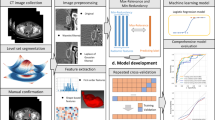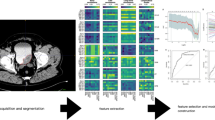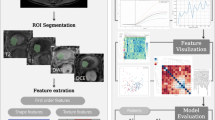Abstract
Purpose
To investigate the value of radiomics features from diffusion-weighted imaging (DWI) in differentiating muscle-invasive bladder cancer (MIBC) from non-muscle-invasive bladder cancer (NMIBC).
Methods
This retrospective study included 218 pathologically confirmed bladder cancer patients (training set: 131 patients, 86 MIBC; validation set: 87 patients, 55 MIBC) who underwent DWI before biopsy through transurethral resection (TUR) between July 2014 and December 2018. Radiomics models based on DWI for discriminating state of muscle-invasive were built using random forest (RF) and all-relevant (AR) methods on the training set and were tested on validation set. Combination models based on TUR data were also built. Discrimination performances were evaluated with the area under the receiver operating characteristic (ROC) curve (AUC), accuracy, sensitivity, specificity, and F1 and F2 scores. Qualitative MRI evaluation based on morphology was performed for comparison.
Results
No significant difference was found between RF and AR models. RF model was more sensitive than TUR (0.873 vs 0.655, p = 0.019) for discriminating muscle-invasive bladder cancer. When combining RF with TUR, the sensitivity increased to 0.964, significantly higher than TUR (0.655, p < 0.001), MRI evaluation (0.764, p = 0.006), and the combination of TUR and MRI (0.836, p = 0.046). Combining RF and TUR achieved the highest accuracy of 0.897 and F2 score of 0.946.
Conclusion
Combining DWI radiomics features with TUR could improve the sensitivity and accuracy in discriminating the presence of muscle invasion in bladder cancer for clinical practice. Multicenter, prospective studies are needed to confirm our results.
Key Points
• Twenty-seven to 51% of superficial bladder cancers diagnosed by transurethral resection are upstaged to muscle-invasive at radical cystectomy, suggesting its poor sensitivity for discriminating muscle-invasive bladder cancer.
• A small subset of selected all-relevant radiomics features exhibited an equivalent performance compared to that of all the extracted features, confirming that radiomics data contained redundant or irrelevant features and that feature selection should be performed in building radiomics models.
• Combining DWI radiomics features with transurethral resection could improve in clinical practice the sensitivity and accuracy for the detection of muscle invasion in bladder cancer.





Similar content being viewed by others
Abbreviations
- ACC:
-
Accuracy
- AR:
-
All-relevant
- AUC:
-
Area under the receiver operating characteristic curve
- BC:
-
Bladder cancer
- CIS:
-
Carcinoma in situ
- DKI:
-
Diffusion kurtosis imaging
- DTI:
-
Diffusion tensor imaging
- DWI:
-
Diffusion-weighted imaging
- GLCM:
-
Gray-level co-occurrence matrix
- GLRLM:
-
Gray-level run length matrix
- GLSZM:
-
Gray-level size zone matrix
- ICC:
-
Intraclass correlation coefficient
- MDGini:
-
Mean Decrease in Gini index
- MIBC:
-
Muscle-invasive bladder cancer
- NGTDM:
-
Neighborhood gray-tone difference matrix
- NMIBC:
-
Non-muscle-invasive bladder cancer
- PPV:
-
Positive predictive value
- RC:
-
Radical cystectomy
- RF:
-
Random forest
- ROC:
-
Receiver operating characteristic
- SEN:
-
Sensitivity
- SPE:
-
Specificity
- TUR:
-
Transurethral resection
- VOI:
-
Volume of interest
References
Babjuk M, Böhle A, Burger M et al (2017) EAU guidelines on non-muscle invasive urothelial carcinoma of the bladder: update 2016. Eur Urol 71:447–461
Alfred Witjes J, Lebret T, Compérat EM et al (2017) Updated 2016 EAU guidelines on muscle-invasive and metastatic bladder cancer. Eur Urol 71:462–475
Karakiewicz PI, Shariat SF, Palapattu GS et al (2006) Precystectomy nomogram for prediction of advanced bladder cancer stage. Eur Urol 50:1254–1260
Shariat SF, Palapattu GS, Karakiewicz PI et al (2007) Discrepancy between clinical and pathologic stage: impact on prognosis after radical cystectomy. Eur Urol 51:137–149 discussion 49-51
Svatek RS, Shariat SF, Novara G et al (2011) Discrepancy between clinical and pathological stage: external validation of the impact on prognosis in an international radical cystectomy cohort. BJU Int 107:898–904
Shariat SF, Margulis V, Lotan Y, Montorsi F, Karakiewicz PI (2008) Nomograms for bladder cancer. Eur Urol 54:41–53
Green DA, Rink M, Hansen J et al (2013) Accurate preoperative prediction of non-organ-confined bladder urothelial carcinoma at cystectomy. BJU Int 111:404–411
Shariat SF, Passoni N, Bagrodia A et al (2014) Prospective evaluation of a preoperative iomarker panel for prediction of upstaging at radical cystectomy. BJU Int 113:70–76
Takeuchi M, Sasaki S, Ito M et al (2009) Urinary bladder cancer: diffusion-weighted MR imaging—accuracy for diagnosing T stage and estimating histologic grade. Radiology 251:112–121
Green DA, Durand M, Gumpeni N et al (2012) Role of magnetic resonance imaging in bladder cancer: current status and emerging techniques. BJU Int 110:1463–1470
Lee M, Shin SJ, Oh YT et al (2017) Non-contrast magnetic resonance imaging for bladder cancer: fused high b value diffusion-weighted imaging and T2-weighted imaging helps evaluate depth of invasion. Eur Radiol 27:3752–3758
Panebianco V, De Berardinis E, Barchetti G et al (2017) An evaluation of morphological and functional multi-parametric MRI sequences in classifying non-muscle and muscle invasive bladder cancer. Eur Radiol 27:3759–3766
Wang F, Chen HG, Zhang RY et al (2019) Diffusion kurtosis imaging to assess correlations with clinicopathologic factors for bladder cancer: a comparison between the multi-b value method and the tensor method. Eur Radiol 29:4447–4455
Aerts HJ, Velazquez ER, Leijenaar RT et al (2014) Decoding tumour phenotype by noninvasive imaging using a quantitative radiomics approach. Nat Commun 5:4006
Gillies RJ, Kinahan PE, Hricak H et al (2016) Radiomics: images are more than pictures, they are data. Radiology 278:563–577
Kotrotsou A, Zinn PO, Colen RR (2016) Radiomics in brain tumors: an emerging technique for characterization of tumor environment. Magn Reson Imaging Clin N Am 24:719–729
Lee G, Lee HY, Park H et al (2017) Radiomics and its emerging role in lung cancer research, imaging biomarkers and clinical management: state of the art. Eur J Radiol 86:297–307
Li ZC, Zhai G, Zhang J et al (2019) Differentiation of clear cell and non-clear cell renal cell carcinomas by all-relevant radiomics features from multiphase CT: a VHL mutation perspective. Eur Radiol 29:3996–4007
Zhang X, Xu X, Tian Q et al (2017) Radiomics assessment of bladder cancer grade using texture features from diffusion-weighted imaging. J Magn Reson Imaging 6:1281–1288
Wang H, Hu D, Yao H et al (2019) Radiomics analysis of multiparametric MRI for the preoperative evaluation of pathological grade in bladder cancer tumors. Eur Radiol. https://doi.org/10.1007/s00330-019-06222-8
Wu S, Zheng J, Li Y et al (2017) A radiomics nomogram for the preoperative prediction of lymph node metastasis in bladder cancer. Clin Cancer Res 23:6904–6911
Xu X, Liu Y, Zhang X et al (2017) Preoperative prediction of muscular invasiveness of bladder cancer with radiomic features on conventional MRI and its high-order derivative maps. Abdom Radiol (NY) 42:1896–1905
Xu X, Zhang X, Tian Q et al (2019) Quantitative identification of nonmuscle-invasive and muscle-invasive bladder carcinomas: a multi parametric MRI radiomics analysis. J Magn Reson Imaging 49:1489–1498
Verma S, Rajesh A, Prasad SR et al (2012) Urinary bladder cancer: role of MR imaging. Radiographics 32:371–387
Bermingham ML, Pong-Wong R, Spiliopoulou A et al (2015) Application of high-dimensional feature selection: evaluation for genomic prediction in man. Sci Rep 5:10312
Acknowledgements
The authors thank their colleagues of the department of radiology of their institute.
Funding
This study has received funding by the National Natural Science Foundation of China; contract grant numbers are the following: Youth Program Nos. 81601487 and 81672514.
Author information
Authors and Affiliations
Corresponding authors
Ethics declarations
Guarantor
The scientific guarantor of this publication is Guangyu Wu.
Conflict of interest
The authors of this manuscript declare no relationships with any companies whose products or services may be related to the subject matter of the article.
Statistics and biometry
One of the authors has significant statistical expertise.
Informed consent
Written informed consent was waived by the Institutional Review Board.
Ethical approval
Institutional Review Board approval was obtained.
Methodology
• Retrospective
• Diagnostic or prognostic study
• Performed at one institution
Additional information
Publisher’s note
Springer Nature remains neutral with regard to jurisdictional claims in published maps and institutional affiliations.
Rights and permissions
About this article
Cite this article
Xu, S., Yao, Q., Liu, G. et al. Combining DWI radiomics features with transurethral resection promotes the differentiation between muscle-invasive bladder cancer and non-muscle-invasive bladder cancer. Eur Radiol 30, 1804–1812 (2020). https://doi.org/10.1007/s00330-019-06484-2
Received:
Revised:
Accepted:
Published:
Issue Date:
DOI: https://doi.org/10.1007/s00330-019-06484-2




